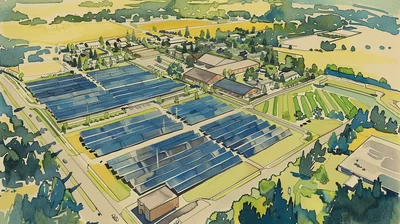The U.S. power grid is teetering on the edge of a crisis that too few are talking about. The latest capacity auction by PJM Interconnection—the largest regional transmission organization in the country—sounded an alarm that policymakers and the general public alike can no longer afford to ignore. With prices surging by over 800% compared to last year, the auction’s results are a stark indicator of a system under strain, primarily due to energy policies that have not adequately prioritized reliable, dispatchable power generation.
The drive toward “net zero” emissions by 2050 has led to the accelerated retirement of coal, natural gas, and nuclear power plants—sources of energy that have reliably powered our nation for decades. In their place, we’ve seen a push for renewable energy sources like wind and solar. While these alternatives are crucial for reducing carbon emissions, they are not yet capable of providing the consistent, reliable power needed to maintain grid stability, especially during peak demand or extreme weather events.
The recent auction highlighted this imbalance starkly: prices soared to $269.92 per megawatt-day, a dramatic increase from the previous year’s $28.92. This spike is not just an abstract figure—it’s a sign of a deepening crisis that will affect every American. Industrial consumers, particularly those in energy-intensive industries, are likely to see their costs rise by millions per month. These increases will inevitably trickle down to everyday consumers through higher prices for goods and services, further straining household budgets that are already stretched thin by inflation.
There is a growing disconnect between rising energy demand and the pace of new power generation. PJM’s 2025/2026 Base Residual Auction revealed that the region’s supply-demand balance is tightening to precarious levels. The auction procured 135,684 MW of capacity, slightly above the target reserve margin, but notably lower than previous years. This decreasing reserve margin signals an increasing vulnerability in the grid’s ability to meet future demand, especially as power plants retire and new generation projects face delays.
The problem is not just the retirement of old plants but also the sluggish construction of new ones. PJM’s recent auction secured only 110 MW of capacity from new generation—a significant drop from the previous year—highlighting the slow pace of new construction. PJM has warned that, at the current rate, the grid could face significant shortfalls by the end of this decade, especially as demand is expected to surge by 40 GW due to electrification and large new loads like data centers.
This isn’t just a concern for energy experts or policymakers—this is an issue that affects everyone. Higher capacity prices will inevitably lead to higher costs for industrial consumers, who may pass those costs onto everyday consumers through higher prices for goods and services. In a time when inflation is already straining household budgets, this added burden could be significant.
The situation here in Ohio exemplifies a broader problem. Across the state, there is widespread local opposition to solar developments. While some might be quick to label this opposition as shortsighted, it’s crucial to understand the underlying concern: these projects represent a poor utilization of the land and will not solve the energy crisis in the way we need. The resistance is not just about aesthetics or land use—it’s about the very real fear that our current energy policies are setting us up for failure.
The push for renewables has been heralded and bankrolled by government subsidies and mandates, but the reality is that wind and solar cannot yet replace the energy density and reliability of other dispatchable power sources. As PJM’s own projections show, the rapid retirement of thermal generation is outpacing the construction of new, reliable resources. The capacity auction’s 833% price hike is a direct consequence of this imbalance, and it’s a warning sign that should not be ignored.
The future of our energy grid cannot be left to chance. We need a balanced approach that prioritizes grid reliability while still advancing our collective environmental goals. This means recognizing the limitations of current renewable technologies and ensuring that we have the necessary backup power from reliable, dispatchable sources.
As we look ahead, it’s clear that the stakes are high. If we continue on the current path without significant investment in new, effective power generation, we risk plunging our nation into an era of energy insecurity and economic instability.
The challenges we face are not limited to Ohio or any specific region—they are national in scope and demand our immediate attention. The resistance to solar developments in Ohio is a reflection of a broader concern that must be addressed: the need for a balanced, realistic energy policy that can secure our grid’s future.







